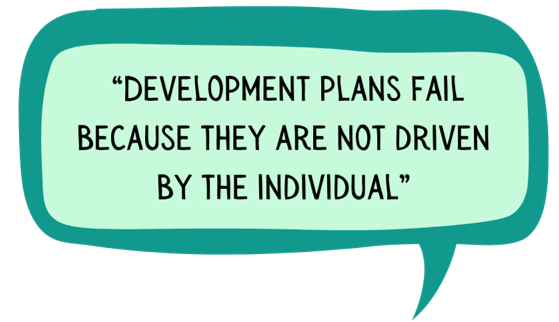
The Challenge
It is no secret that most individual development plans (IDP) fail, and it also failed in my case. Specifically, the problem with my IDP was that all goals were always due on the last date of December. They were like empty maps with the destination set clearly but no paths, no milestones, no checkpoints, nothing to help me get there. Besides, the more I talk with individuals about the IDP process, the more I realize that most see it as a paper-passing, bureaucratic practice with little real value. Worse, managers consider IDP as another check-the-box exercise that wastes valuable time rather than a process as doing much to really develop talent.

Another thing these plans have in common was they included at least one strategic goal, linked to the company strategy; however, very seldom was the strategy laid out in front of me, explained properly for me to get a grip of what my contribution could be and how it would be implemented into the big picture. In fact, most IDP conversations involve the manager convincing subordinates to develop capabilities the manager thinks are important. They address the organizational need but neglect the individual’s interest.
In general, I believe that most often IDP ignores the importance of the individual’s personal energy and motivation and is not explicit about the value the organization places on the individual developing that very skill. Certainly, this lack of an individual-driven plan is likely to be the root cause of IDP failure.
The Idea & Solution
When the process of tackling this very clear problem - the inefficient and costly Individual Development Plans - begins, my top priority is to build something that would ensure that the plan is more than just a destination. The path needs to have steppingstones leading to the destination. These steppingstones should be concrete and have clear measures the employee would take, learn, and do to reach the target.
It is also of high importance for me to address the missing transparency between colleagues, teams, and employees in different departments. Creating transparency to skills, goals and showing how each and everyone’s plan connected to the vision or strategy are my way of ensuring a unified understanding, experience, and way of working. As a result, people can know how their work may affect their team’s progress and how their team’s goals would be part of the organizational bigger picture.
The Result
One late spring afternoon, I met with a friend of mine to test the idea on him. While demonstrating how each employee builds their development path, links personal goals to the company objectives, and makes those paths transparent, my friend said to me:

I had never heard about the OKR framework, but after this meeting, I started digging, searching, and learning anything I can find about OKR. I ordered the Measure What Matters book and read it. The more I read, the more I got fired up about it and it all made sense! I googled articles, blogs, etc. and sorted out great ideas, then turning and tossing them around with my team. And at the end of the day, with the help from the OKR framework and adding the concepts and designs of our own, we have developed Talbit ideology where we believe strategy belongs to everyone and each employee should have the autonomy to contribute to it through personal development and subsequently created Talbit — the employee-driven talent management platform.
Talbit - The strategic & agile employee-driven development platform
Talbit is based on the employee-driven ideology, where the employee is in the center of it all. Opposite of one size fits all. More specifically, the strategy sets the goal and schedule for the whole company and each employee will journey there in an autonomous but systematic way. In other words, the employee’s growth plan reflects the personal style of growing and contributing to the strategy.

The Objectives and Key Results are also created into Talbit, visible for all. Teams will then work together to create suitable Team OKRs, connected to the company KRs. Once that is done, each employee can connect to the greater plan through a personal and agile growth plan. The plan follows the OKR-framework but Os are Goals and KRs are Milestones, connecting to the Team or Company OKRs.
In addition, a personal coach is assigned to support the growth and keep the focus on things that matter. Continuous 1-on-1 discussions with the coach will keep the focus on things that matter and allow implementing any necessary changes to the plan. Again, this is all possible because of the employee-driven, forward-looking agile growth plan.
In conclusion, with Talbit, each employee can create a development plan that fits their learning rhythm in the best way. Individuals are also allowed to contribute to the team objectives and company strategy autonomously, which can create a positive employee experience. Moreover, Talbit can help create the company and team-level objectives and key results and link everyone's personal growth plans to the company strategy easily and transparently. As a result, better employee engagement, motivation, profitability, and employer branding is likely to be achieved with Talbit.






.gif)




